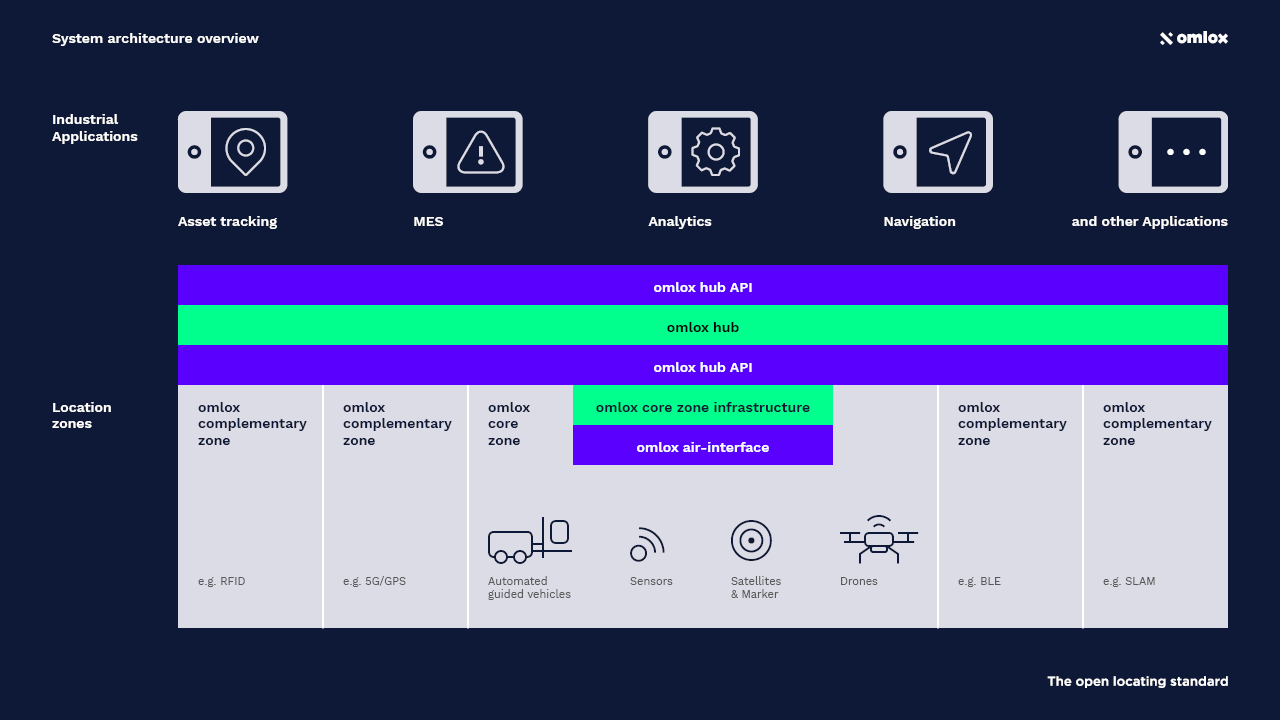How omlox reduces Total Cost of Ownership
Introduction
![]()
In today’s interconnected and mobile world, everything moves. This is particularly true in logistics, where supply chains are complex and diverse. Having a clear overview and the ability to effectively manage this movement is paramount for the large-scale success of organizations. Reliable, seamless location data is an integral ingredient to achieve this. When used in an efficient and sustainable manner, it allows businesses to utilize fewer resources in terms of time, costs, materials, and energy. This is realized through the adoption of a real-time location system (RTLS) – a strategic combination of hardware (i.e., location sensors/readers, nodes/tags/badges) and software (i.e., location engine, middle-ware, application).
The market for RTLSs is saturated with many different locating technologies and providers – each with its own pros and cons in terms of technical capabilities and commercial attributes. Furthermore, there’s no silver bullet in terms of locating technologies, as a single technology cannot satisfy all the requirements of many use-cases. Combining different locating technologies can increase the total cost of ownership (TCO), as there are many proprietary solutions that do not easily function together. A flexible, modular, and interoperable solution should be the ultimate goal for companies utilizing an existing RTLS or those looking to incorporate an RTLS into their solution.
omlox in a Nutshell
In order to streamline processes and operate effectively, organizations need a clear, consistent view of everything that moves –for all use-cases and applications. However, this often proves to be challenging, given the dynamic and fluid nature of individual system components and processes. This is where omlox, the world’s first open locating standard, provides the solution. omlox standardizes software and hardware aspects of locating systems, ensuring that RTLSs are affordable and accessible for organizations of any size, including small and medium-sized enterprises (SMEs). As a widely recognized and utilized standard, omlox facilitates true vendor independence, comprehensive interoperability, and simple integration of technologies and systems across location and company boundaries.
Through the omlox standard, all locating technologies can be integrated into a solution – irrespective of the vendor. This interoperability opens the door to a wide spectrum of use-cases and guarantees scalability, flexibility, and cost reduction. This is further reinforced through the large omlox ecosystem of partners. This ecosystem comprises of organizations from various disciplines and specialties, including RTLS providers, hardware and software providers, IT system integrators, and full solution providers.
In addition, omlox enables various industries to use a single infrastructure with different applications from different providers. As the same infrastructure is used, it lowers the TCO, enabling easy integration of different applications.

The general architecture of omlox consists of three key components:
- omlox hub – a locating middle-ware that harmonizes location data from any source (i.e., omlox zones). Furthermore, it transforms location data into standardized, global coordinates and provides it to any system or application via the standardized omlox hub API.
- omlox core zone – a zone defining an area with ultra-wideband (UWB) coverage that works in conjunction with open interfaces and guarantees interoperability. Organizations can easily network all UWB products using the omlox standard, regardless of the manufacturer.
- omlox complementary zones – zones defining all other locating technologies that are specified and standardized in other industry associations. These could include RFID, Wi-Fi, BLE, 5G, etc.
Cost Drivers for RTLS Projects
With any project involving an RTLS, there will be inherent costs that need to be considered, such as the necessary hardware, installation, software integration, and operations. While the cost drivers for traditional RTLS projects can be high, due to the limited technical scope of RTLS vendors and lock-in effects, an omlox RTLS project would equate to a lower overall TCO.
Hardware Costs
 In the past few years, there has been a growing wave of locating technologies being integrated into consumer products. This is particularly true with UWB, where chips have been incorporated into smartphones, automobiles, laptops, mass-market wearables, and smart home products. As the prevalence of UWB continues to increase and gain wide-spread adoption, the large-scale production of tags and chipsets from different vendors will result in competition and innovation. In turn, UWB chips will become more affordable to meet the growing demand.
In the past few years, there has been a growing wave of locating technologies being integrated into consumer products. This is particularly true with UWB, where chips have been incorporated into smartphones, automobiles, laptops, mass-market wearables, and smart home products. As the prevalence of UWB continues to increase and gain wide-spread adoption, the large-scale production of tags and chipsets from different vendors will result in competition and innovation. In turn, UWB chips will become more affordable to meet the growing demand.
In the context of industrial environments, having an open RTLS infrastructure enables interoperability and multi-purpose usage. A single infrastructure that supports mobile entities from different vendors will ensure a better ROI, as the variety of possible use-cases is increased. In contrast, a closed, proprietary infrastructure will not easily support and communicate with hardware from different vendors.
The omlox hub, which acts as the center of omlox, allows for this open and interoperable RTLS infrastructure. Through the hub, organizations may embed and combine locating technologies from any vendor. This facilitates strategic financing of RTLS projects, as organizations may combine highly accurate and costly RTLS with more cost-efficient proximity-based locating technologies. In the case of brownfield projects, existing locating technologies installed at a facility can be easily integrated through an omlox hub – eliminating the need to start from scratch.
Installation Costs
Ultimately, the goal of a company wanting to install an RTLS in their facility is to ensure that it meets current requirements while also being future-proof. When installing an RTLS at a facility, there are several considerations that can reduce the TCO for the project. For example, reducing installation costs can be accomplished in various ways, such as integrating the RTLS into existing hardware (i.e., lighting or Wi-Fi). Additionally, wiring costs can be reduced through a wireless uplink of the omlox core zone (e.g., via Wi-Fi6 or 5G). Integrated products that comprise, e.g., lighting and locating, allow for a more streamlined planning and installation process when planning new buildings or upgrading lighting setups to meet higher energy efficiency measures.
Software Integration Costs
Previously, complex RTLS projects required the integration of several APIs to manage location data – thereby increasing the overhead and development resources required. However, when integrating an omlox RTLS solution, the software integration is streamlined through the omlox hub API. The omlox hub API supports all current, and future locating technologies and only needs to be integrated once for custom projects or software applications.
The hub standardizes location data into geo-referenced, global coordinates. Data cleanup is not necessary, as this is done automatically through the hub, and data can immediately be used for analytics and process optimization. Through the standardized system behavior, the implementation of different technology providers will behave the same. Finally, the omlox standard is aligned with other software standards in the Industrial Internet of Things (IIoT). These include OPC-UA, IDTA, and AIM.
Operation Costs
In terms of operations and IT, these costs can be reduced due to the flexible deployment that is possible with the omlox hub. The hub can run on tiny edge nodes or in large cloud environments. Even cascaded setups spanning different production sites and cloud installations are possible. Additionally, the operation setup can be adapted to the needs and IT policies of customers. This enables true data sovereignty. As the omlox hub allows for standardized systems, API, and system behavior, maintenance of the RTLS solution is simplified.
The large partner ecosystem of omlox, which comprises organizations around the globe from various disciplines, allows for truly robust and modular RTLS projects. If support is needed for an RTLS solution, it can be provided by local IT service providers. It is not mandatory for the technology vendor to provide support. Therefore, support can be coordinated from a company that is geographically close to the facility and provided in a manner that is cost and time efficient.
Summary
Planning, maintaining, or upgrading an RTLS solution comes with several key factors that need to be considered to reduce TCO and maximize ROI. The benefits and added-value of the omlox approach described above illustrate how an omlox-compatible RTLS would lower costs while streamlining processes and workflows. This enables SMEs with lower budgets to also benefit from RTLS and increase their profits.
If you are considering implementing or upgrading an existing RTLS, consider an omlox RTLS. The standardized interfaces ensure a sustainable and long-lasting RTLS, as any future technologies will be compatible with the omlox standard. Furthermore, all omlox-compliant products must be certified by an accredited certification center. You can rest assured that each component of the RTLS is of the highest quality and is backed by continuous development and support.

